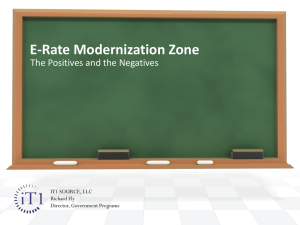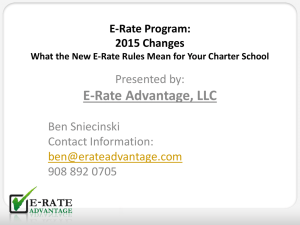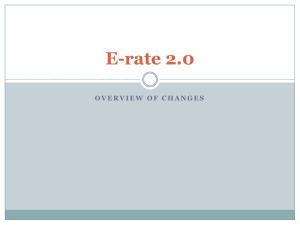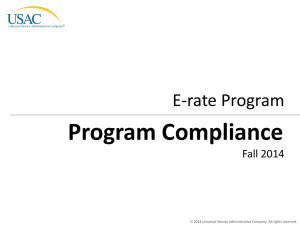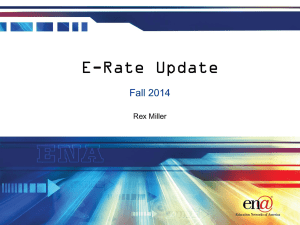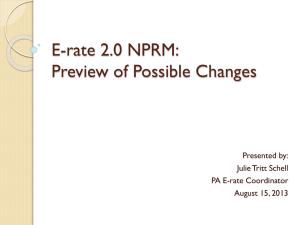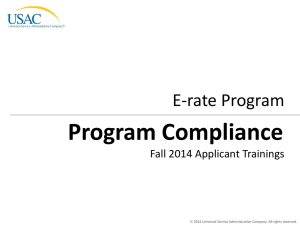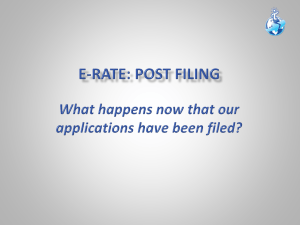Summary of E-Rate Changes
advertisement
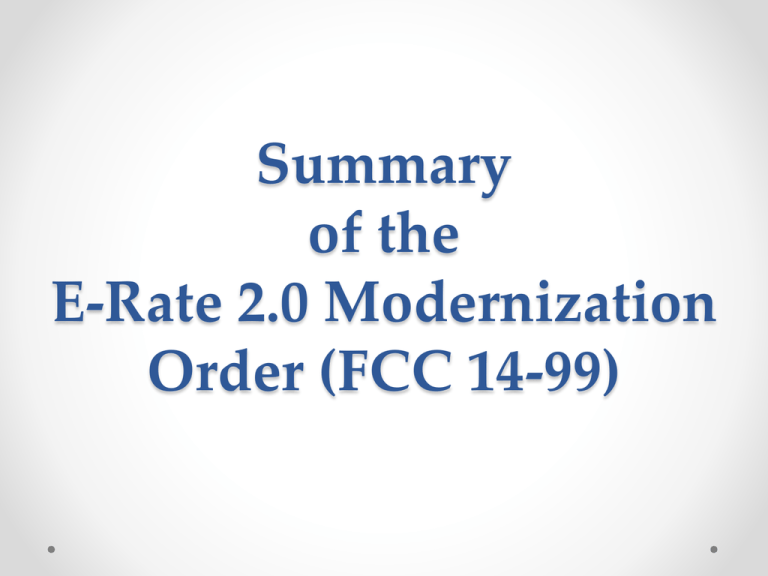
Summary of the E-Rate 2.0 Modernization Order (FCC 14-99) The FCC released the first E-rate modernization Order (FCC 14-99) July 23, 2014. We are referring to this as the “first” Order because we are expecting companion releases later this year, including: 1. A draft and subsequent final Eligible Services List for FY 2015; 2. Changes to the Form 470 and Form 471 (and maybe other forms); 3. A follow-up order related to the Further Notice of Proposed Rulemaking included with this first Order; 4. One or more possible “clarification” orders addressing questions raised by the first Order; and 5. A second E-rate modernization order focusing on Category 1 issues. The major provisions of the first Order, most importantly designed to reorient the E-rate program to focus on broadband services, are summarized below. Performance Goals and Measures: • Ensuring affordable access to high-speed broadband sufficient to support digital learning in schools and robust connectivity for all libraries. • Maximizing the cost-effectiveness of spending for Erate supported purchases. • Making the E-rate application process and other Erate processes fast, simple, and efficient. More specifically, the Order establishes an Internet connectivity goal for schools, consistent with the President’s ConnectEd initiative, of at least 100 Mbps per 1,000 students in the short-term, and 1 Gbps per 1,000 students in the longer-term. The WAN connectivity goal for schools focuses on the “scalable capacity” of 10 Gbps per 1,000 students. The equivalent Internet connectivity goal for libraries is 100 Mbps for those serving fewer than 50,000 people, and 1 Gbps for those serving larger populations.. The Wireline Competition Bureau is directed to revise information collection from applicants and vendors to reflect data on these measures. The Order sets an application processing “target” to have “USAC to aim to issue funding commitments or denials for all ‘workable’ funding requests by September 1st of each funding year,” while explicitly acknowledging that this may not be possible during the FY 2015 transitional year. Support of Internal Connections: • In a change of nomenclature, the old Priority 1 and Priority 2 designations are being replaced with “Category 1” and “Category 2” to make a clearer distinction and to establish separate funding targets for connectivity to buildings (“C1”) and connectivity to devices within buildings (“C2”). • Beginning with FY 2015, Category 2 will cover only broadband distribution services and equipment including: routers, switches, wireless access points, internal cabling, racks, wireless controller systems, firewall services, uninterruptable power supply, and related software. Managed Wi-Fi, caching, and maintenance will also be eligible, at least for the first two years. Previously eligible P2 services such as servers, telephone switches, and VoIP components will no longer be covered. The FCC is targeting at least $1 billion per year in C2 discounts over the next five years. To allocate these funds, the FCC plans a two-year test of a per-school or per-library budget limitation capping the amount of funding any one applicant can receive (and replacing the existing 2-in-5 restriction). The budgets would work as follows: • Individual schools can receive C2 discounts on up to a total pre-discount budget amount of $150 per student over a five year period. • Formula … Total Student Enrollment * $150 * .85 • The minimum pre-discount budget (or “floor”) for a small school or library is $9,200. • The maximum C2 discount will be 85%, not 90%. All other discounts levels (for both C1 and C2) remain the same. Priority 2 Discount Matrix Changes • Maximum Category 2 discount will change from 90% to 85% • All other discount bands will remain the same NSLP Eligibility Urban Rural Less than 1% 20% 25% 1 – 19 % 40% 50% 20 – 34% 50% 60% 35 – 49% 60% 70% 50 – 74% 80% 80% 75 – 100% 85% 85% According to FCC estimates, this budget-limited plan would provide adequate funding to assure Wi-Fi system build-outs and management over the five-year span for all applicants (assuming the two-year test mechanism is extended). While this may be true as a whole, timely funding for individual applicants is less predictable. With no P2 funding in FY 2013 (and presumably none in FY 2014), the demand for C2 funding in FY 2015 (and maybe FY 2016) is likely to exceed the targeted $1 billion in funding in that year. In that case, C2 funding will be limited to the higher discount level applicants, as in the past. The added twist under this Order is that if only partial funding is available at a given discount rate, a further threshold will be established based on applicants’ actual student eligibility percentages. Category 2 Funding Budgets • Each school building will be permitted to apply for a pre-discount cap of $150 per student, or a minimum building cap of $9200, over a rolling five-year basis • Money is allocated per building (not on a districtwide basis), and applicants cannot move funding from one school to another • Funding may be requested over 5 years, or applied for in a single year -Annual application is required and funding approval is subject to available funds each year Category 2 Funding Budgets (Cont’d) • If an applicant requests less than the maximum budget available for a building in a single year, the applicant may request the remaining balance in subsequent years of the five-year cycle • No look-back provision for applicants funded in years prior to FY2015 • All competitive bidding requirements will continue to apply and applicants can only apply for what they need -Possible Preferred Master Contract bidding exemption Category 2 – NonInstructional Facilities • Non-Instructional Facilities are not eligible for equipment unless the NIF has classrooms or the NIF houses the WAN/WLAN central equipment • such as the network operations center) • For NOCs, applicants must allocate a portion of each school’s $150 budget toward the purchase of such equipment Category 2 – New Schools • New schools may estimate the number of students who will be attending the new school and seek funding based on that estimate • However, if an applicant overestimates the number who enroll in that school, it must return to USAC by the end of the next funding year any excess funding based on the actual number of enrolled students Category 2 – Students in Multiple Schools • Students who attend multiple schools, such as those that attend Cooperative Districts of CTCs part-time, may be counted by both schools in order to ensure appropriate LAN/WLAN deployment for both buildings Category 2 – Early Installation • Eligible equipment may be purchased and/or installed on or after April 1 prior to the beginning of the funding year • This provides maximum amount of time during the summer to complete the necessary work • Disbursements will not be made until on or after July 1 • General rule still applies that applicants cannot apply for retroactive funding for equipment purchased and installed in years prior to the funding year Eliminating, Phasing-Out, or Narrowly Defining Support for “Legacy” Services: The re-focusing of E-rate on broadband connectivity both to and within schools and libraries will mean — and to a large extent be funded by — a concurrent phase-out of support for non-broadband or “legacy” services. In particular, as of FY 2015: 1. E-rate support will be completely eliminated for: • • • • • • • • • • Paging Email Web hosting Voice mail Directory assistance Text messaging Custom calling features Direct inward dialing (“DID”) 900/976 call blocking Inside wire maintenance plans 2. Support for voice telephone services will be phased out. Voice services are defined to include: • • • • • • • Local and long distance phone service (often referred to as “POTS”) 800 service Satellite telephone Centrex Wireless telephone service (including cellular voice services) Voice over IP Circuits dedicated to providing voice services • The phase-out of voice services will be accomplished by reducing an applicant’s discount rate for those services by 20 percentage points per year. Thus an applicant with a 90% discount rate will receive a 70% discount on voice services in FY 2015, 50% in FY 2016, 30% in FY 2017, 10% in FY 2018, and nothing in FY 2019. A 40% applicant will receive a 20% discount on voice services in FY 2015, and nothing in FY 2016. • From an applicant’s perspective, the implementation of these changes will require a thorough review of its carriers’ bills to identify and breakout (i.e., cost allocate) various charges. A typical wireline telephone bill, for example, may include: (a) numerous small ineligible charges; (b) non-voice data circuits, which are fully eligible; and (c) voice telephone charges, which must be filed for in a separate FRN at a lower discount rate. Similarly, a cellular bill is likely to include: (a) ineligible text messaging charges; (b) voice service charges (again requiring a separate FRN at a lower discount rate); and (c) data services that will remain fully eligible only if the applicant can demonstrate the cost-effectiveness of the service as an internal Wi-Fi system. Voice Phase Out Schedule If Your District Discount is: FY 2015 FY 2016 FY 2017 FY2018 FY2019 No Funding No Funding No Funding No Funding No Funding No Funding No Funding No Funding No Funding No Funding No Funding No Funding No Funding No Funding No Funding No Funding No Funding No Funding No Funding No Funding No Funding No Funding 20% No Funding 25% 5% 40% 20% 50% 30% 10% 60% 40% 20% 70% 50% 30% 10% 80% 60% 40% 20% 90% 70% 50% 30% 10% No Funding Maximizing Cost-Effectiveness: In line with the FCC’s goal to drive down the costs of broadband equipment and services, the Order does the following: • Provides greater transparency on pricing by standardizing Item 21 product and service descriptions and, more importantly, making the pricing on this information public. • Encourages consortia and bulk purchasing by: o o Speeding the review of consortium applications — a process already noticeably in effect for FY 2014. Creating a limited number of “preferred master contracts” for Category 2 equipment. Presumably, such contracts would be similar to the arrangement that the FCC announced last month to leverage GSA pricing. The interesting twist, if such contracts are available, is that applicant’s would have to include those contract prices in their bid evaluations. • Reminds service providers that their bids and pricing must conform to the Lowest Corresponding Price (“LCP”) requirements, and directs the FCC’s Enforcement Bureau to devote additional resources to investigate and enforce LCP. Simplifying the E-Rate Process: Although some of the new provisions discussed above appear to complicate the E-rate process, the Order also contains a number of other provisions designed, at least in principle, to simplify applications, discount rate calculations, invoicing and disbursement, and other aspects. Changes to the application process, beginning with FY 2015, include the following: • Multi-year contracts (up to five years) will be reviewed in depth only in the first year. Subsequent year applications will be reviewed using streamlined and expedited procedures. • Technology plans will not be required for either Category 1 or Category 2 services. • Lower-dollar purchases of “commercially-available businessclass Internet services” will be exempt from competitive bidding rules (i.e., no Form 470s, bid assessments, etc.) Internet services covered by this exemption must provide speeds of at least 100 Mbps downstream and 10 Mbps upstream, and have an annual pre-discount cost of no more than $3,600 per school. • Electronic filings by applicants, and applicant notifications by USAC, will be required by FY 2017. Pricing Transparency • Item 21 information will be standardized to provide meaningful information that is easy to compare across applicants and will be made public in electronic format in bulk data files and/or through publicly available application processing interfaces • Such information will be considered nonconfidential unless an applicant can certify that the disclosure of price information violates a statute, regulation or court order • New contracts cannot contain self imposed prohibition on price disclosure unless required by state law or court order Lowest Corresponding Price • LCP is the price charged to non-residential customers who are similarly situated to a particular school, library, rural health care provider or consortium that purchase directly from the service provider • In order to ensure prices paid for E-rate services and equipment are as low a possible, service providers are required to offer in their bids LCP and to charge applicants the LCP for such services and equipment • Applicants are encouraged to verify that the service provider’s bid complies with the LCP requirement and services providers are obligated to ensure that the price charged applicants complies with LCP • FCC’s Enforcement Bureau intends to increase LCP enforcement • Discount rates for districts will be based on the district-wide percentage eligibility of students rather than on a weighted average of individual school discount rates. For many districts, this will result in either an increase or decrease in their overall discount rate to the nearest “matrix” discount rate. For example, a district with a current discount rate of 56% will most likely have a 60% discount in FY 2015, while a district currently at 54% will most likely fall to 50%. The district discount rate will apply to all funding requests, even if a service is only being provided to a subset of the schools. Consortium discount rates will still be based on the average of their members’ discounts. Other changes affecting discount rates include: • The definition of “rural” and “urban” will now be based on U.S. Census data. For an individual school, the rural/urban classification can be determined by its mailing address using the Census Bureau’s American FactFinder. The rural/urban classification for a district with schools in each category will be determined by the location of the majority of its schools. • The discount rates for schools participating in the Community Eligibility Provision (“CEP”) program will be calculated using the same multiplier (currently 1.6x) of direct certification percentages used for free meal reimbursements. • Household income surveys may still be used to identify eligible students, but discount rate extrapolations based on those surveys will no longer be permitted. This is bound to lower the discount rates of schools that have historically relied on the survey method. Community Eligibility Provision • • • • • • • • CEP program provides a new alternative to NSLP household applications for free and reduced price meals in high poverty LEA’s No longer required to obtain individual income eligibility applications from each student NSLP estimates are derived from existing data from other income-based programs A school, group of schools, or the entire district must have an identified Student Percentage of 40% or more and must offer both breakfast and lunch daily to qualify for CEP For E-rate, CEP schools will use the 1.6 multiplier as is currently permitted by USDA and other federal programs Presumably, the NSLP eligibility data that will be entered into the Form 471. Block 4 discount calculation worksheet will already contain the 1.6 multiplier CEP schools must retain back-up calculations which may be requested during PIA and audits The previous FCC guidance that CEP schools must use the NSLP data from the year before they opted into CEP has been repealed • Beginning with FY 2016, BEAR reimbursement payments will be made directly to applicants, and will no longer have to be funneled through the service providers (nor will the applicants be required to have the service providers approve their BEAR forms). Direct applicant BEAR payments will be made by electronic transfer (requiring applicants to provide USAC with appropriate bank account information). • Beginning with FY 2014, invoicing deadlines may be extended once upon request for 120 days. Requests for further extensions, under “extraordinary circumstances,” may be granted only by the FCC. The objective of this change is to permit USAC to “de-obligate” unused funds at an earlier date. Other changes designed to simplify the E-rate process, for either the applicants or the program administrators, include: • Creating a consultation and outreach program for Tribal schools and libraries. • Requiring all appeals — exclusive of requests for FCC rule waivers — to be made first to USAC. • Establishing specific targets for application reviews, commitment decisions, and funding disbursements. • Modernizing USAC’s information technology systems, including the creation of “an online portal with pre-populated information for returning applicants and service providers.” • Publishing “all non-confidential E-rate data in open, standardized, electronic formats.” • Adopting “plain language” review correspondence. • Extending the document retention requirements from five to ten years. • Clarifying the right of auditors, investigators, and other persons appointed by local, state, and federal authorities to access applicant and service provider sites for inspections. • Finally, recognizing “the complexities associated with modernizing the E-rate program” as it pertains to the rules modifying the rules and other programmatic changes adopted in the Order, the FCC has delegated authority to the Wireline Competition Bureau “to make any further rule revisions as necessary to ensure the changes to the program adopted in this Report and Order are reflected in our rules. This includes correcting any conflicts between new and/or revised rules and existing rules as well as addressing any omissions or oversights.” Priority 1 Bundled Equipment Limitations • Beginning in FY2015, equipment is not permitted to be bundled at no cost with an eligible service • This includes free cellular phones, iPads/tablets, and VOIP equipment • Applicants will be required to perform a cost allocation to remove the value of the ineligible equipment form the pre-discount price claimed for the annual service costs • Previously signed contracts are not grandfathered • This rule resulted from an FCC Order in May 2014 and is not technically in the July Reform Order Impact of the new erate changes • It takes roughly about $350,000 to upgrade the campus infrastructure (cabling, switches, and wireless). • Based on a student count of 600 students, a campus that qualifies for 85% discounts would get ($150. * 600 * .85) $ 76,500. • This means a district would have to come up with $273,500 to upgrade this campus. • If you are upgrade 10 campuses with similar student enrollment… o You would have to come up with $ 2,735,000 to upgrade these 10 campuses.
